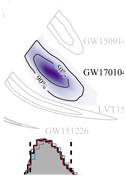| GW170104: Observation of a 50-solar-mass binary black hole coalescence at redshift 0.2 |
| June, 1, 2017 |
 |
We describe the observation of GW170104, a gravitational-wave signal produced by the coalescence of a pair of stellar-mass black holes. |
|
![]()
| GW170104: Observation of a 50-solar-mass binary black hole coalescence at redshift 0.2 |
| June, 1, 2017 |
 |
We describe the observation of GW170104, a gravitational-wave signal produced by the coalescence of a pair of stellar-mass black holes. |
|
![]()
Beyond the standard model
Astroparticle physics
Cosmology
Gravitational waves experiments
Astrophysics
Neutrinos
|
| ©2010 COSMOVIA - All Rights reserved |